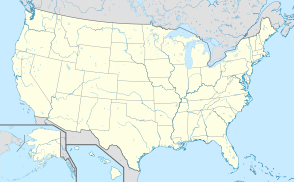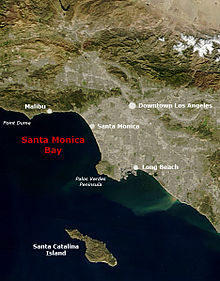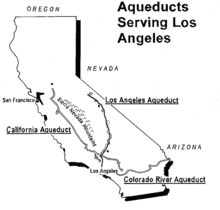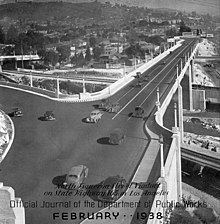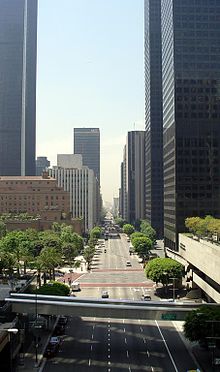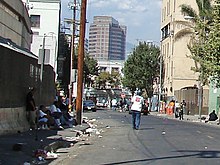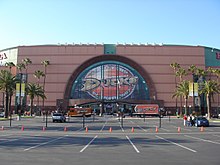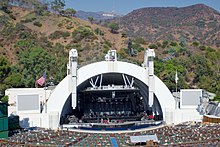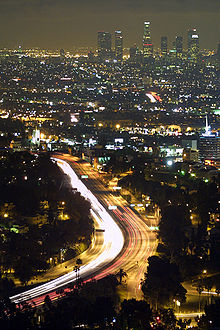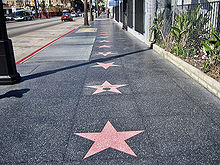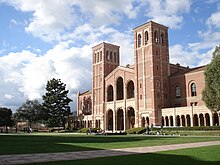Los Angeles
| Los Angeles | |
|---|---|
| Nicknames : LA, City of Angels, City of Flowers and Sunshine, La La Land, The Big Orange, Southland, El Pueblo | |
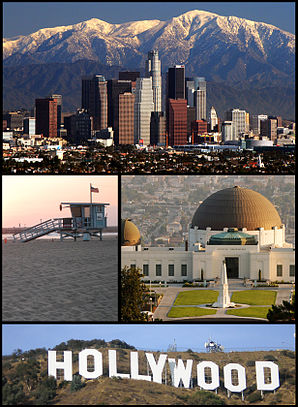 From top left to bottom right: Downtown Los Angeles , Venice , Griffith Observatory , Hollywood Sign |
|
 seal |
 flag |
| Location in county and California | |
| Basic data | |
| Foundation : | September 4, 1781 |
| State : | United States |
| State : | California |
| County : | Los Angeles County |
| Coordinates : | 34 ° 3 ′ N , 118 ° 15 ′ W |
| Time zone : | Pacific ( UTC − 8 / −7 ) |
| Residents : | 3,898,747 (as of 2020) |
| Population density : | 3,209 inhabitants per km 2 |
| Area : | 1,290.6 km 2 (approx. 498 mi²) of which 1,214.9 km 2 (approx. 469 mi²) are land |
| Height : | 100 m |
| Structure: | 15 boroughs |
| Postcodes : | 90001-90068, 90070-90084, 90086-90089, 90091, 90093-90097, 90099, 90101-90103, 90174, 90185, 90189 |
| Area code : | +1 213, 310, 323, 424, 661, 818 |
| FIPS : | 06-44000 |
| GNIS ID : | 1662328 |
| Website : | www.lacity.org |
| Mayor : | Eric Garcetti ( D ) |
Los Angeles on the map of the United States |
Los Angeles [ lɔs ˈændʒələs ] (from Spanish Los Ángeles [ losˈaŋxeles ], German 'The Angels' ), officially City of Los Angeles , often abbreviated to LA , is the largest city in the US state of California . It is located on the Pacific Ocean and the Los Angeles River .
With a population of 3,898,747 (2020) in the metropolitan area, Los Angeles is the second largest city in the United States after New York City and before Chicago . With 11.8 million inhabitants in the agglomeration as well as over 12.8 million inhabitants in the Metropolitan Statistical Area and almost 17.8 million in the enlarged metropolitan region, the Greater Los Angeles Area ranks 18th among the largest metropolitan regions in the world . The people of Los Angeles are called Angelenos [ ændʒəˈlinoʊz ].
Los Angeles is the capital and administrative seat of Los Angeles County . The city is the economic, business and cultural center of California with numerous universities such as USC and UCLA , colleges, research institutes, theaters and museums. Los Angeles is the world's largest location for the aircraft and space industry and is known for the film and television industry ( Hollywood ) and music scene located there.
The Los Angeles metropolitan area achieved an economic output of around 1.04 trillion US dollars in 2017. It ranks third among the world's cities behind Tokyo and New York City.
name of the city
The city was officially founded on September 4, 1781 by the Spanish governor Felipe de Neve as El Pueblo de la Reina de Los Ángeles ( Spanish "The village of the Queen of Angels"). The name thus referred to Mary as Queen of Angels , a Mary title that comes from the Lauretan litany . The current name Los Angeles is an abbreviation of the founding name on "the angels".
The unofficial name El Pueblo de Nuestra Señora la Reina de los Ángeles del Río de Porciúncula [ el ˈpweβlo de ˈnwestɾa seˈɲoɾa la ˈrei̯na de los ˈaŋxeles del ˈrio de poɾsiˈuŋkula ] (The Lady of the River Angels) was also widespread Portiuncula ). He makes specific reference to the Basilica of Santa Maria degli Angeli in Assisi, built over the Portiuncula chapel, in which Francis of Assisi died. He was the founder of the order that included the missionaries who came to America with the explorers.
Contrary to popular belief that this was the original name, scientists have found from official documents from Governor Felipe de Neve, Commander-in-Chief Theodor de Croix and Viceroy Antonio María de Bucareli y Ursúa that the settlement was simply called El Pueblo de la Reina de Los Ángeles wore.
The abbreviation often used (also colloquially) is "LA". Because of the Spanish meaning of the city name, the city bears the nickname City of Angels (City of Angels ) .
geography
location
The city center and the suburbs of Los Angeles are located in a hilly coastal region on average 100 meters above sea level . To the west and south, the city is bordered by the Santa Monica Bay of the Pacific Ocean . In the east and north it is surrounded by mountain ranges. Also in the north of the city is the San Fernando Valley , where a third of the residents live in single-family homes. The valley is cut off from Hollywood and downtown by Griffith Park and the Santa Monica Mountains .
The administrative city area has an area of 1290.6 km². Of this, 1214.9 km² are land and 75.7 km² are water. The urban area extends 71 km in north-south direction and 47 km in east-west direction. It is connected by a system of highways made of steel and concrete structures. The city is burdened by the greatest density of motor vehicles in the world, and car and industrial emissions have become an urgent environmental problem . As a result, Los Angeles is one of the most exposed cities in the United States from smog .
The city is sometimes referred to as the horizontal city because it has relatively few skyscrapers and the entire urban area is very extensive. In the center of Los Angeles, however, high land prices mean that high-rise buildings are now also establishing themselves there. The agglomeration, i.e. the continuously built-up area, covers an area of 4320 km².
There are several definitions of the Los Angeles metropolitan area:
- The Metropolitan Statistical Area (MSA) comprises the 15 boroughs (Districts) of Los Angeles and the two counties of Los Angeles (Metropolitan Division Los Angeles-Long Beach-Glendale) and Orange (Metropolitan Division Riverside-San Bernardino-Ontario). It has a floor area of 12,562 km².
- The Combined Statistical Area (CSA) includes 173 independent cities. It includes Los Angeles, San Bernardino , Riverside , Ventura, and Orange counties . The expanded metropolitan area thus extends to the border of Nevada and has an area of 87,941 km². Only a fraction of this area is used for urban development. The largest part consists of uninhabited parts, namely the Mojave Desert and Joshua Tree National Park , which is located in Riverside and San Bernardino Counties.
geology

The San Andreas Fault runs on the eastern edge of the metropolitan region ; in addition, the Puente Hills Fault is just below the city . The resulting earthquake hazard explains the stringent building codes that are applied throughout Southern California's earthquake area. Since 1800, Los Angeles has been hit by nine major earthquakes, magnitude six and higher, and thousands of smaller quakes. Numerous buildings are earthquake-proof , which significantly reduces the number of deaths in quakes.
Until 1958, there was also a legal requirement according to which the upper limit for buildings could not exceed 45 meters or 14 floors. The only exception was the town hall from 1928 with 138 meters. Earthquake-proof constructions later made the law superfluous. The threat from earthquakes, the abandonment of dense development and the definition of a model, according to which Los Angeles should become more of a kind of “City in the Garden”, were the ideas behind this regulation. This, too, is an explanation for the expansion of the city.
The worst earthquake in recent history was the Fort Tejon earthquake on January 9, 1857, near the present-day parishes of Wrightwood and Palmdale . The earthquake with a magnitude of 7.9 caused only minor damage, as the region was only sparsely populated at the time. If such a quake occurred today, it would cause billions of dollars in damage and significant human life losses.
On March 10, 1933, the Long Beach earthquake with a magnitude of 6.4 claimed 120 lives. Property damage of $ 50 million resulted in Long Beach and other locations. Many of the damaged buildings were not built to be earthquake-proof. Another major earthquake occurred on February 9, 1971 with a magnitude of 6.6. The so-called San Fernando earthquake of 1971 (also known as the Sylmar earthquake ) caused damage of 500 million US dollars in the San Fernando Valley and claimed 65 lives. The earthquake on June 28, 1991 had a magnitude of 5.8 but caused no surface fracture because of its depth. Nonetheless, damage totaling 40 million US dollars was incurred, mainly in the San Gabriel Valley .
On January 17, 1994, a 6.7 magnitude earthquake struck the city of Los Angeles. The epicenter of the Northridge earthquake was in the Reseda neighborhood of the San Fernando Valley. 57 people were killed and 12,000 injured. Major transport links and an estimated 100,000 buildings were damaged or destroyed. According to the Federal Emergency Management Agency (FEMA), property damage amounted to $ 40 billion.
In 2008, the US Geological Survey (USGS) and the Southern California Earthquake Center published a new study. The researchers forecast a major earthquake of magnitude 6.7 for California by 2038 with a 99.7 percent probability. A quake of magnitude 7.5 or more was predicted with a 46 percent probability. Greater Los Angeles is a little more at risk than San Francisco in the north of the state. The possibility of a magnitude 6.7 quake is 67 percent in Los Angeles and 63 percent in San Francisco.
On July 29, 2008, at 11:42 a.m. local time, a 5.4 magnitude earthquake was recorded. The epicenter was about 46 km east-south-east of the city center, near Chino Hills .
City structure

Los Angeles is divided into 15 districts. The population figures refer to the census of April 1, 2000.
| Borough | Area in km² |
of inhabitants number |
Inhabitants per km² |
|---|---|---|---|
| 1st District | 36.17 | 236.344 | 6,534 |
| 2nd District | 130.64 | 258,603 | 1,980 |
| 3rd District | 107.54 | 258,788 | 2.406 |
| 4th District | 78.00 | 252,787 | 3,241 |
| 5th District | 122.72 | 258,749 | 4.106 |
| 6th District | 63.02 | 235.885 | 3,743 |
| 7th District | 78.09 | 235,869 | 3,020 |
| 8th District | 46.35 | 243.108 | 5,245 |
| 9th District | 38.09 | 236.932 | 6.220 |
| 10th District | 35.19 | 243,664 | 6,924 |
| 11th District | 167.68 | 258,433 | 1,541 |
| 12th District | 161.31 | 242,361 | 1,502 |
| 13th District | 34.01 | 244,369 | 7.185 |
| 14th District | 59.43 | 235.036 | 3,955 |
| 15th District | 99.74 | 253,884 | 2,545 |
| Los Angeles | 1,257.97 | 3,694,813 | 2,937 |
Type of settlement

The Los Angeles area is characterized by extreme urban sprawl . The entire city is broken up like a mosaic into a multitude of individual city districts. The districts have different functions, such as business districts or residential areas, and are clearly differentiated from one another. In the individual residential districts there are population groups who also differ significantly in terms of origin, education, income or age structure. The districts are partially isolated from each other, and not infrequently even sealed off by walls or fences. There is no dominant center in the entire city region. The city center, the downtown Los Angeles does have, about the only Group of skyscrapers in the vast sea of houses and also has a symbolic meaning, however, is only one of many municipalities. Within the agglomeration of Los Angeles there are many districts with their own center, character and specialized functions, such as Long Beach , Santa Ana , Anaheim or Pasadena .
This diversification and fragmentation is on the one hand a problem, but on the other hand it can also be one of the reasons for the rise of the city. Los Angeles is one of the most heterogeneous cities in the world, shaped by the individualism of its residents. Different milieus and lifestyles exist side by side, which means that the urban space can no longer be recognized as a coherent unit. This is particularly reflected in the lack of a clearly identifiable center. A number of new terms have been developed for these post-modernist forms of settlement since the end of the 20th century, such as exopolis , post-metropolis or the term Zwischenstadt . Such cities are often referred to as edgeless cities or edge cities , as suburban , post-urban or even desurban areas. The term urban country hybrid is an attempt to take account of the developments in post-modern forms of settlement - with a focus on Los Angeles. Such agglomerations represent a new type of spatial development, "the prerequisite for which is extensive suburbanization." The research group at the Los Angeles School of Urbanism devoted itself to researching these developments, particularly in the late 1980s and 1990s .
climate
The city is located in the subtropical climatic zone . The average annual temperature is 18 degrees Celsius and the average annual rainfall is 305 millimeters. The warmest months are July and August with an average of 22.8 degrees Celsius and the coldest is January with an average of 13.2 degrees Celsius. Almost all of the annual precipitation falls in the months of November to March, so it is mostly dry between May and October.
In the summer in Los Angeles during the day temperatures usually around 22 to 25 degrees Celsius. Without the location on the Pacific coast, it would be even warmer as the wind from the sea weakens the temperatures. In winter, on the other hand, it is a little colder, with temperatures almost never dropping below 15 degrees Celsius. At night, the temperature drops by an average of around ten degrees Celsius. The humidity is 50 to 75 percent.
Typical of the climate in the Los Angeles region are also several, relatively clearly delimited, smaller climate zones. The main reason for this lies in the various mountain ranges that separate the Los Angeles Basin from, for example, the San Fernando Valley and other areas further inland. In the San Fernando Valley, for example, it is often several degrees warmer in summer than on the coast, while it is noticeably cooler there in winter.
Heat waves occur every two to three years and temperatures can rise to over 40 degrees Celsius. The reason for this are the so-called Santa Ana winds , which come over the Santa Ana Mountains from the deserts east of the city. Extensive forest and bush fires occur again and again. On October 3, 1933, one of the worst bush fires in the United States killed 29 firefighters in Griffith Park . Between late October and early November 1993, fires in the Los Angeles metropolitan area destroyed thousands of acres of built-up land. The highest temperature was measured on July 22, 2006 in Woodland Hills with 48.3 degrees Celsius, the lowest temperature on February 6, 1989 in Canoga Park with −7.8 degrees Celsius.
| Los Angeles | ||||||||||||||||||||||||||||||||||||||||||||||||
|---|---|---|---|---|---|---|---|---|---|---|---|---|---|---|---|---|---|---|---|---|---|---|---|---|---|---|---|---|---|---|---|---|---|---|---|---|---|---|---|---|---|---|---|---|---|---|---|---|
| Climate diagram | ||||||||||||||||||||||||||||||||||||||||||||||||
| ||||||||||||||||||||||||||||||||||||||||||||||||
|
Average monthly temperatures and rainfall for Los Angeles
Source :; wetterkontor.de
|
|||||||||||||||||||||||||||||||||||||||||||||||||||||||||||||||||||||||||||||||||||||||||||||||||||||||||||||||||||||||||||||||||||||||||||||||||||||||||||||||||||||||||||||||||||||||||||||||||||
environmental issues


The major air pollution - high levels of ozone , nitrogen oxide and hydrocarbons - in Los Angeles, caused by the local industry and car traffic, is a cause for concern . The Los Angeles / Long Beach / Riverside metropolitan area was the most polluted urban area in the United States in 2007, according to a report by the American Lung Association. In addition to industries and everyday traffic in private cars and trucks, air pollution can be largely attributed to inland port traffic, i. H. the trucks that carry goods between the quay and the storage area and where the engines are often idling. Electric heavy-duty trucks, which have been introduced since 2009, are intended to provide a remedy.
The concentrations of pollutants are particularly high in morning and evening rush hour traffic. The photochemical smog , the main component of which is ozone, on the other hand, reaches its highest concentration at noon. Since the city is surrounded by mountain ranges, the exchange of air with the vast surrounding area is inhibited. The sea breeze only reaches the Los Angeles Basin without breaking up the inversion weather over the city.
Ozone and other chemicals cause coughs, eye irritation, headaches and lung dysfunction in the population. Efforts have been made to solve the problem since the early 1980s. In 1979, increased pollutant levels were measured on 120 days a year, in 1996 - after the introduction of catalysts - only on seven days. In the new millennium, the number of smog days has dropped to almost zero. Even so, the Greater Los Angeles area still releases one of the largest amounts of toxic gases in the country. The main reason is the poorly developed public transport.
Air pollution in Los Angeles also endangers the more distant mountain lakes and snow-capped regions of the Sierra Nevada and is responsible for forest dieback . Strong winds carry the pollutants as far as Palm Springs in Riverside County , where they lead to increased concentrations of pollutants.
story
City foundation
The first European in the region was the explorer Juan Rodríguez Cabrillo , who claimed the land for Spain in 1542 without establishing a settlement. In 1771, Spanish Franciscan monks founded the “San Gabriel” mission near Whittier Narrows, which later became the starting point for colonizing the region. The Spanish missions in California were intended to expand the influence of Spain and the power of the Church. To protect them from attacks by the indigenous people living there , the mission was fortified with a fort.
After the mission was established, the Spanish governor of California, Felipe de Neve, sent eleven families to cultivate the land. On September 4, 1781, the Los Angeles Community was established with 44 settlers on the territory of the Tongva indigenous people. At that time there was still mainly cattle breeding. In the following decades, the first US settlers established themselves in the region.
In 1821 Los Angeles fell to Mexico , which had gained independence from Spain after a long war. In 1835, the Mexican Congress raised the settlement to a city and at the same time the capital of Mexico's northernmost region, Alta California . The second part of the decree was never enforced and was soon revised. So Monterey remained the capital of California until 1849. The population of Los Angeles grew to 2,228 people by 1836, after which it fell again temporarily. Los Angeles was a Mexican community until the mid-19th century, but it consisted primarily of American settlers, poor Chinese workers, and a few wealthy Mexican landowners.
In 1846 the schoolmaster William Ide proclaimed the independence of California. The republic only existed for a short time. During the Mexican-American War between 1846 and 1848, Alta California and with it Los Angeles were occupied by US soldiers and annexed to the USA. Gold was found north of Sacramento in 1848 , which triggered the famous gold rush . Numerous prospectors came to the area, from which Los Angeles also benefited by selling meat, fruit and vegetables to the Diggers .
Shortly thereafter, the first of two European pharmacists (both of German descent) arrived in Los Angeles. The first was the pharmacist Theodore Wollweber. In 1861 Adolph Junge settled down as the second pharmacist. He ran his "drug store" in the "Temple Block" on Main Street for around 20 years. The later well-known German pharmacist FJ Gieze worked as an employee at Junge in 1874. The young recipe book and his estate are now in the Natural History Museum of Los Angeles .
industrialization

The place received the US city charter on April 4, 1850 as part of the establishment of the state of California by the United States; at that time it had 1,610 inhabitants. Los Angeles remained almost untouched by the Civil War (1861-1865) between the southern states that had left the United States - the Confederation - and the northern states that remained in the Union .
Floods in 1861/62 and a subsequent devastating drought led to the ruin of many farms specializing in cattle breeding. At the same time, a new upswing began, mainly due to property speculation. The result was an increase in land prices and the influx of numerous Chinese, Japanese and European immigrants.
The rejection of Chinese migrants by large parts of the US population grew into anti-Chinese hysteria during the economic crisis of the 1870s. On October 24, 1871, a racist uprising broke out in Los Angeles after a white man was accidentally killed in a war between rival Chinese gangs. In the further course of the uprising, a mob of more than 500 people of European descent invaded Chinatown and killed 19 of the residents. Only one of those killed was involved in the original gang war. In addition, a white man had been killed trying to prevent the killing.
The largest immigrant group came from the Midwest, from states like Iowa and Indiana , and replaced the old Mexican elite as the new political class. The old large farms were soon parceled out and the population grew. From 1870 to 1900, the city's population increased from just under 6,000 to around 102,000. In the first ten years of the 20th century, the population even more than tripled (1910: 319,000 inhabitants). Extensive incorporations also contributed to this enormous growth, including the cities of Wilmington and San Pedro (both 1909) in the south and Hollywood (1910) in the west. From 1899 to 1914, today's Port of Los Angeles was built in San Pedro . In 1915, the largest area of annexation came when most of the San Fernando Valley was annexed to Los Angeles.
The railway was to prove to be an important development engine for the next few decades. In 1869 the first railway line was opened in Los Angeles. It ran over 34 kilometers from today's city center to the then still independent San Pedro, where the port of Los Angeles is now. But it was only after the Union Pacific Railroad in 1876 ( San Francisco ) and the railroad to Santa Fe in 1885 established connections to the rest of the country that the city's growth accelerated. At this time, new irrigation techniques were tried out and crops suitable for the region, such as B. Oranges discovered. The city soon became synonymous with good health, a clean environment, plenty of sun and endless citrus plantations in the metropolises of the eastern United States. The two competing railroads soon undercut each other with low prices for tickets from the East Coast, helping to attract settlers to Los Angeles.
From 1890 coal was mined. Far more important for further development, however, turned out to be the extensive oil reserves under the city, which were first drilled in 1892 near what is now Dodger Stadium . From then on, the derricks quickly spread across large parts of the region. In the first half of the 20th century Los Angeles became one of the most important centers of oil production and in 1923 a quarter of the world's oil was produced in the Los Angeles region. Even today, oil production still plays a certain role.
In order to ensure the enormous growth also for the future, those responsible in the city thought about the water supply of Los Angeles in the years before the turn of the century. For a city located in a semi-arid climate zone , this was and is an extremely important issue. Until then, Los Angeles was supplied with drinking and process water by the nearby Los Angeles River . When its water supplies were no longer sufficient, the first Los Angeles aqueduct was built in the north in 1913 , which carried water from the Owens Valley, 300 kilometers away, to Los Angeles. With cheap drinking water supplies, Los Angeles was able to accommodate numerous surrounding communities in the years before and after 1910, including Wilmington , San Pedro (both 1909), and Hollywood (1910).
In 1910, film producers discovered the Los Angeles area as an ideal production site and moved from New York and Chicago to Hollywood. In the following years Gilbert M. Anderson achieved great success with his westerns and Mack Sennett with his slapstick comedies. When in 1927 the film The Jazzsinger helped the sound film make its breakthrough, another upswing set in. The Hollywood-based film industry became one of the major industries in the United States, drawing many newcomers to Los Angeles. The first monumental film in color - David O. Selznick's film Gone with the Wind - was released in 1939 and won ten Academy Awards .
In the 1920s, numerous other neighboring communities were incorporated, such as Sawtelle (1922), Hyde Park (1923), Eagle Rock (1923), Venice (1925), Watts (1926), Barnes City (1927) and Tujunga (1932). Santa Monica and Beverly Hills , which are economically and culturally regarded as parts of Los Angeles, have managed to maintain their independence to this day.
The Olympic Games of 1932 are undoubtedly one of the most important events of the 1930s . For the first time in the history of the Games, an Olympic village was built for the male participants on this occasion . Today the village is part of the Baldwin Hills borough . In the same year 1932, the population of Los Angeles rose to over a million.
business center
As early as the middle of the 20th century, the small suburban house with swimming pool and double garage had become a permanent symbol of the city. A great boom began during the Second World War with the aerospace industry, which settled in large numbers in the greater Los Angeles area as a result of the war.
Numerous German-speaking cultural workers and intellectuals chose Los Angeles as a place of refuge from the National Socialists . These included Bertolt Brecht , Marlene Dietrich , Lion Feuchtwanger , Otto Klemperer , Fritz Lang , Ernst Lubitsch , Heinrich Mann , Thomas Mann , Luise Rainer and Billy Wilder . But artists from other countries also found a new home here: Luis Buñuel , Jean Renoir , Igor Stravinsky , Arturo Toscanini and many others. Numerous great works by poets, conductors, directors and painters were created in exile; the emigrants made Los Angeles a vibrant center of European culture in the 1940s.
But the city also continued to struggle with racist violence. In 1943 there was a series of riots that went down in history as Zoot Suit Riots . They caught fire between the soldiers stationed in the city and Mexican-American youth gangs, led by so-called pachucos , who were known for the zoot suits they wore.
As early as the 1920s, the automobile had become the preferred means of transport for the Angelenos , despite an efficient tram network . In that decade, Los Angeles had more cars relative to its population than any other major American city. On January 1, 1940, the Arroyo Seco Parkway , the first urban freeway, opened between Pasadena and northern city center. This marked the course for further development. After the war, companies like General Motors , Greyhound Lines and Firestone Tire & Rubber Company bought and then dismantled the Los Angeles Railway tram network - this process went down in history as the great American tram scandal . In its place a widespread motorway network was built. According to the premise of the 1950s, no citizen should live more than six kilometers from a motorway entrance. In 1960 the first high-rise office building was built in the formerly low silhouette of the city, the tallest structure of which was the City Hall from 1928.
In August 1965 serious race riots broke out in Los Angeles' southern district of Watts . The riot , known as the Watts riot , claimed 32 lives and 874 injuries within six days. The property damage amounted to 45 million US dollars.
The rapidly increasing car traffic led to the first problems from the late 1970s. Smog , decentralization and a sharp rise in crime shaped the image of the city. Since the beginning of the 1990s, however, LA has been working on the construction of a light rail network again , after the local public transport of the metropolis had to make do with buses for almost three decades. However, the financial and bureaucratic effort involved in building the metro is much greater than when building the original network, as not only is the city much more densely built up today, but earthquakes must also be taken into account when building the underground routes .
The riot in Los Angeles from April 29 to May 2, 1992 was one of the largest racial riots in US history. It was triggered by the acquittal of four white police officers accused of mistreating African American Rodney King . 53 people died in the riots, 2,383 were injured and property damage amounted to 800 million US dollars.
With the end of the Cold War in 1990, an important branch of the city's economy, the aerospace industry, was badly affected. After the terrorist attacks on September 11, 2001 and the realignment of the defense strategy to combat terrorism , this branch of industry is again of great economic and strategic importance for the USA. At the beginning of the 21st century, the status of the city as the cultural and economic center of the region is undisputed. Problems that the city is struggling with are unemployment, enormous traffic, environmental pollution and gang crime.
population
Religions
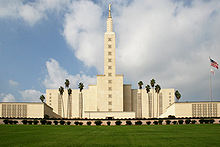
Los Angeles is home to many religious followers. Among the more than 100 Christian denominations, the Roman Catholic Church is dominant due to the large number of Hispanics . Other important Christian denominations are the Adventists , Baptists , Lutherans , Methodists , Orthodox and Jehovah's Witnesses . Smaller religious groups are followers of the Baha'i religion, Buddhism , Hinduism , Islam , the Jewish religion, Mormonism , Sikhism , Sufism and Zoroastrianism .
The region's Roman Catholic Church is organized in the Archdiocese of Los Angeles . It was established on June 1, 1922 as the diocese of Los Angeles – San Diego and raised to an archdiocese on July 11, 1936 . With 4.2 million believers (2004) it is considered the largest diocese in the United States. It is one of the typical cardinal seats of the Catholic Church, whose archbishop has six auxiliary bishops available to carry out his pastoral duties . The ecclesiastical province now includes the dioceses of Fresno , Monterey , Orange , San Bernardino and San Diego . Archbishop of Los Angeles has been José Horacio Gómez since 2011 . The 2002 to plans by the Spanish architect Rafael Moneo completed Cathedral of Our Lady of the Angels (Cathedral of Our Lady of the Angels) is the Episcopal Church of the Archdiocese.
In the city stands with the "Los Angeles California Temple" built in 1956, the second largest shrine (after the Salt Lake Temple) of the Church of Jesus Christ of Latter-day Saints (Mormons). The temple is 112 meters long, 82 meters wide and 78 meters high. At the top of the temple tower is a statue of the angel and prophet Moroni .
Los Angeles has the third largest Jewish community in the United States (after New York and Miami ) with 490,000 people (2001) . There are many synagogues in the city, most of them in the San Fernando Valley and West Los Angeles.
Due to the large number of immigrants from Asia, the Buddhist community has seen strong growth in recent years. Los Angeles currently has the largest Buddhist population in the United States and is home to a wide variety of schools and systems of Buddhism . There are more than 300 Buddhist temples spread across the city.
Numerous Hindu swamis and gurus have been practicing in Los Angeles since the beginning of the 20th century . The Self-Realization Fellowship (Community of self-realization) is based in Hollywood and has a private park in Pacific Palisades . The non-profit religious society was founded in Los Angeles in 1920 by Paramahansa Yogananda as the "Church of All Religions". This is also where the founder of the Hare Krishna movement (ISKCON), Bhaktivedanta Swami , built its main global center from 1968 onwards. ISKCON's Krishna temple on Watseka Avenue is open daily and is supported by many Hindus of Indian descent. On the chariot festival Ratha-yatra on Venice Beach in July each participate tens of thousands of people.
Population development
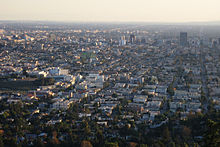
The population explosion in the 20th century - in 1900 the city only had 102,000 inhabitants - hit Los Angeles completely by surprise. New buildings such as single-family houses, commercial buildings or shopping centers were mostly built as low-rise buildings, which meant that the city expanded enormously in area. The population is still increasing today. Immigration from Latin America , especially from Mexico , as well as from Asia , also plays an important role . More than a third of the Los Angeles population was born outside of the United States.
Los Angeles is home to people from a total of 140 countries who speak 224 different languages. According to the 2010 census , the 1.8 million Latinos made up 48.5% of the total population of the city, which is approximately 3.8 million people. 28.7% of Los Angeles residents were white (non-Hispanic) . The Afro-Americans had a share of 9.6%, the indigenous people made up the smallest group of the population with 0.7% or 28,215 people. The Asians and immigrants from the Pacific Islands, predominantly Chinese, Japanese, Koreans, Vietnamese, Thais and Filipinos, are also growing rapidly. Together with the Iranians, they made up 13.0% of the city's total population. A language other than English is spoken in 60% of households, mainly Spanish. However, due to an English-speaking environment, such as at school or in the media, the majority of US-born Latinos speak and understand good English.
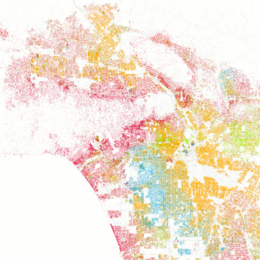
Although there is a strong mix of cultures in the city and in Los Angeles County , as in all international cities and metropolitan regions with a multicultural population, there is a certain division of residential areas according to ethnic or cultural origin. Such “divisions” almost always flow into one another and merge with one another.
Urban areas with a very high proportion of Latinos are classically East Los Angeles and Montebello , in which more and more people from Latin America, especially Mexico, but also El Salvador and Honduras have settled since the 1970s, and sometimes even at the beginning of the century . In addition, South Los Angeles , also known as South Central , is a district with a very large Hispanic population, whose share in some eastern districts is often over 90%. Districts and cities such as Huntington Park , South Gate , Lynnwood , Bell (California) , Bell Gardens as well as Lennox , Hawthorne and Westlake are also very strongly Hispanic. Many African Americans live in western South Los Angeles . Likewise, urban areas or cities such as Inglewood , Crenshaw , Leimert Park , Westmont and Compton are mostly black populated. Asians , mainly East and Southeast Asians such as Chinese, Taiwanese and Vietnamese of Chinese descent, mostly live in Monterey Park and in the area around Alhambra in the western San Gabriel Valley. In addition, there are significant Asian populations in LA County's cities such as Torrance , Carson , Gardena, and Koreatown and Chinatown . The majority of the white population lives along the Pacific coast from Rancho Palos Verdes to Redondo Beach , Manhattan Beach , El Segundo , Marina del Rey to Santa Monica and between Lakewood and eastern Long Beach . Furthermore, a larger white population lives in the area between Santa Monica and Hollywood . The areas in between include West Los Angeles, Culver City , Beverly Hills , West Hollywood, and Hancock Park . The neighborhoods on and on the edge of the Santa Monica Mountains such as Pacific Palisades , Brentwood , Westwood , Bel Air , Hollywood Hills , Loz Feliz and Silver Lake also have mostly white residents.
According to the 2010 census, there were 3,792,622 residents, 1,413,955 households and 807,326 families in the city area. The median income per household was $ 49,497. About 22% of the people lived below the poverty line .
On July 1, 2006, there were 3,877,129 people in the Los Angeles administrative metropolitan area. The population density was 2,812 inhabitants per square kilometer. In the metropolitan area (Metropolitan Statistical Area) lived 12,950,129 people. The population density was 1,031 people per square kilometer. 17,775,984 people lived in the expanded metropolitan area (Combined Statistical Area). The population density was 202 inhabitants per square kilometer.
The following overview shows the population of the city according to the respective territorial status. For the years 1800 to 2010 the census results are given. For July 1, 2013, the United States Census Bureau has an estimate of 3,884,307 residents. This corresponds to a very high growth compared to the period from 1990 to 2010
| Year / date | resident |
|---|---|
| 1781 | 44 |
| 1790 | 139 |
| 1800 | 315 |
| 1810 | 354 |
| 1820 | 650 |
| 1830 | 770 |
| 1836 | 2,228 |
| June 1, 1850 | 1,610 |
| June 1, 1860 | 4,399 |
| June 1, 1870 | 5,728 |
| June 1, 1880 | 11,183 |
| June 1, 1890 | 50,395 |
| date | resident |
|---|---|
| June 1, 1900 | 102,479 |
| April 15, 1910 | 319.198 |
| January 1, 1920 | 576.673 |
| April 1, 1930 | 1,238,048 |
| April 1, 1940 | 1,504,277 |
| April 1, 1950 | 1,970,358 |
| April 1, 1960 | 2,479,015 |
| April 1, 1970 | 2,816,061 |
| April 1, 1980 | 2,966,850 |
| April 1, 1990 | 3,485,557 |
| April 1, 2000 | 3,694,820 |
| April 1, 2010 | 3,792,621 |
| April 1, 2020 | 3,898,747 |
crime

Problems are caused by the high level of crime, especially gang crime. Los Angeles is one of the cities with the highest number of street gangs. According to an estimate by the Los Angeles Police Department (LAPD), more than 400 gangs with at least 39,000 members are active in the city. They face 350 special police officers who specialize in gang crime.
Some areas are very dangerous because of the street gangs, especially at night. These include many districts in the South Los Angeles district as well as the suburbs of Compton and Lynwood . The murder rate in Compton is about six times higher than the US national average.
A total of 132,034 crimes were registered in Los Angeles in 2006 (2005 = 142,506 and 2004 = 163,626). The total crime rate fell by 7.3 percent compared to the same period in 2005, compared to 2004 by 19.3 percent. In the individual sectors, the development in 2006 was as follows (in brackets decrease compared to 2005): 481 murders (−1.8 percent), 903 rapes (−7.2 percent), 14,235 robberies (+5.5 percent), 14,118 serious bodily harm (−9.1 percent), 20,020 burglaries in private apartments and buildings (−8.2 percent), 29,911 thefts from motor vehicles (−8.8 percent), 27,779 thefts of personal belongings / other thefts (−9.3 percent) and 24,587 car thefts (−8.1 percent).
politics
City government
At the head of the Los Angeles city council is the mayor, who is elected by the population for a term of four years. He appoints heads of various departments of the city administration and other civil servants, in some cases with the approval of the city council. The mayor has the right to veto regulations .
The Los Angeles City Council has 15 district council members. It is divided regionally by the districts (Districts) of the city. The city council passes laws, sets the property tax and allocates the financial resources to the individual departments of the city administration. City council elections also take place every four years.
Antonio Villaraigosa won the mayoral elections in 2005 by a large margin. He took over from his predecessor James Hahn on July 1, 2005 , making him the first Hispanic mayor of Los Angeles since the early 1870s. As the last Latino mayor of the city until then, Cristóbal Aguilar left office in 1872.
Villaraigosa took up the fight against widespread corruption shortly after his inauguration , for example by removing all lobbyists from the city's commissions. Important topics during his tenure included the construction of social housing and the creation of public green spaces. He achieved success in public safety. The crime rate fell by 21.8 percent between 2005 and 2015, and has recently been rising again. For example, in 1992 there were 1,094 murders in Los Angeles. For six years (as of 2015) there have been fewer than 300 murders per year, most recently with an increase from 260 (2014) to 283 (2015).
Eric Garcetti has been mayor since the May 21, 2013 election. He is the first Jewish mayor of Los Angeles.
Flag and seal
The flag of Los Angeles was designed in 1931 for the city's 150th anniversary. It consists of three notched vertical stripes in green, gold, and red that represent the major fruits grown in California: olives, oranges, and grapes. The city seal is shown in the middle . The seal contains the coat of arms of the city of Los Angeles, consisting of four fields. The four fields contain the coat of arms of the United States , the flag of California , the coat of arms of Mexico in the version from 1867–1968 and the coat of arms of Castile and León . The last two stand for the history of the city under Mexico, resp. as a Spanish colony. The coat of arms is surrounded by the fruits already mentioned above as well as the legal name of the city (City of Los Angeles) and the date of foundation (1781) .
Town twinning
Los Angeles has partnerships with the following cities:
-
 Athens , Greece (since February 10, 1984)
Athens , Greece (since February 10, 1984) -
 Auckland , New Zealand (since 1971)
Auckland , New Zealand (since 1971) -
 Beirut , Lebanon (since June 20, 2006)
Beirut , Lebanon (since June 20, 2006) -
 Berlin , Germany (since June 27, 1967)
Berlin , Germany (since June 27, 1967) -
 Bordeaux , France (since May 26, 1964)
Bordeaux , France (since May 26, 1964) -
 Busan , South Korea (since April 5, 1971)
Busan , South Korea (since April 5, 1971) -
 Eilat , Israel (since June 18, 1959)
Eilat , Israel (since June 18, 1959) -
 Yerevan , Armenia (since February 23, 2007)
Yerevan , Armenia (since February 23, 2007) -
 Giza , Egypt (since November 21, 1989)
Giza , Egypt (since November 21, 1989) -
 Guangzhou , People's Republic of China (since December 6, 1981)
Guangzhou , People's Republic of China (since December 6, 1981) -
 Ischia , Italy (since November 8, 2006)
Ischia , Italy (since November 8, 2006) -
 Jakarta , Indonesia (since December 28, 1990)
Jakarta , Indonesia (since December 28, 1990) -
 Kaunas , Lithuania (since June 20, 1991)
Kaunas , Lithuania (since June 20, 1991) -
 Lusaka , Zambia (since May 7, 1968)
Lusaka , Zambia (since May 7, 1968) -
 Makati , Philippines (since January 28, 1992)
Makati , Philippines (since January 28, 1992) -
 Mexico City , Mexico (since December 11, 1969)
Mexico City , Mexico (since December 11, 1969) -
 Mumbai , India (since June 1, 1972)
Mumbai , India (since June 1, 1972) -
 Nagoya , Japan (since March 31, 1959)
Nagoya , Japan (since March 31, 1959) -
 Salvador da Bahia , Brazil (since April 26, 1962)
Salvador da Bahia , Brazil (since April 26, 1962) -
 San Salvador , El Salvador (since January 26, 2005)
San Salvador , El Salvador (since January 26, 2005) -
 Saint Petersburg , Russia (since February 10, 1984)
Saint Petersburg , Russia (since February 10, 1984) -
 Split , Croatia (since June 9, 1993)
Split , Croatia (since June 9, 1993) -
 Taipei , Taiwan (since May 18, 1979)
Taipei , Taiwan (since May 18, 1979) -
 Tehran , Iran (since May 26, 1972)
Tehran , Iran (since May 26, 1972) -
 Vancouver , Canada (since June 23, 1986)
Vancouver , Canada (since June 23, 1986)
City friendships
Los Angeles has friendships with the following cities:
-
 Łódź , Poland (since June 2010)
Łódź , Poland (since June 2010) -
 London , United Kingdom (since December 2009)
London , United Kingdom (since December 2009) -
 Manchester , United Kingdom (since December 2009)
Manchester , United Kingdom (since December 2009)
Culture and sights
Music and theater

The Walt Disney Concert Hall designed by Frank Gehry opened on October 23, 2003 . The building is home to the Los Angeles Philharmonic Orchestra under the direction of Gustavo Dudamel and the LA Master Choirs . The construction of the concert hall is the result of a public-private partnership initiative between Lillian Disney (1899–1997), other members of the Disney family as well as sponsors and the Los Angeles administrative district. The Los Angeles Opera has its venue in the Dorothy Chandler Pavilion , part of the Los Angeles Music Center .
The Hollywood Bowl , opened in 1922 , is a natural amphitheater in a hilly landscape in Hollywood . The Hollywood Bowl Orchestra is based here, and the Los Angeles Philharmonic Orchestra is also located here during the summer season. The Beatles , Frank Sinatra and Mikhail Baryshnikov are just a few of the legendary artists who have performed here. Various concerts take place there in the summer months and access to the site is free of charge every day throughout the year.
The Broadway Theater District is home to many large movie theaters. The Bradbury Building , built in 1893, with its sun-drenched atrium and stylish wrought-iron balconies was featured in the film Blade Runner , as was the neighboring Million Dollar Theater from 1918, which now houses a generally accessible parish hall. The United States' first cinema, the Electric Theater , opened in Los Angeles in 1902.
The even more extravagant Los Angeles Theater was completed in just 90 days for the world premiere of Charlie Chaplin's film City Lights in 1931 and invites cineastes to its screening room every June for the Last Remaining Seats film festival . One of the traditional cinemas that are regularly used is the Orpheum , a splendid example of the Neo-Renaissance with sweeping stairs and magnificent chandeliers.
On Hollywood Boulevard stands Grauman's Chinese Theater . It opened in 1927 in the style of a Chinese pagoda. The cinema became world famous for the hand and shoe prints of numerous film stars, which were immortalized in cement blocks in the entrance area of the cinema. Nearby are Grauman's Egyptian Theater , which opened in a pseudo-Egyptian style in 1922, and the Dolby Theater (Kodak Theater until February 2012), in which the Academy of Motion Picture Arts and Sciences has given the Oscars (Academy Awards) since 2002 .
Museums
Los Angeles and the greater Los Angeles area are home to hundreds of museums and collections with different focuses.
The largest and oldest art museum in Los Angeles is the Los Angeles County Museum of Art on Wilshire Boulevard, founded in 1910. It houses a collection of over 100,000 works from ancient times to the present . This makes it the largest museum in the United States west of Chicago . The collections of American, Islamic and Korean art are particularly extensive and significant .
Another important art museum is the J. Paul Getty Museum . It was founded in 1953 by oil billionaire J. Paul Getty and was originally located in a replica of the Villa dei Papiri of Herculaneum in Malibu ( Getty Villa ). Since 1997 it has been located in the Getty Center in Brentwood, a district of West Los Angeles in the Santa Monica Mountains , along with other scientific institutions such as the Getty Research Institute , the Getty Conservation Institute , which works in the field of restoration and the Getty Leadership Institute , which provides education and training for museum leaders. The building complex was designed by the architect Richard Meier , who was commissioned with the design in the mid-1980s. Construction work began in 1991 and lasted until 1997. The museum, which is accessible free of charge, collects antiquities, drawings, illuminations, paintings, photographs, as well as sculpture and handicrafts.
The Museum of Contemporary Art , which opened in 1986, is located on California Plaza , on Grand Avenue . The complex is a playful arrangement of reddish geometric blocks, designed by the architect Isozaki Arata, who described it as a "small village in the valley of the skyscrapers". It houses an impressive collection of paintings and sculptures by Franz Kline , Mark Rothko , Robert Rauschenberg , Claes Oldenburg and Antoni Tàpies .

Located in Exposition Park and founded in 1913, the Natural History Museum of Los Angeles County is the third largest natural history museum in the United States. It has important collections on fauna and flora, including dinosaurs , but also on the city's history. The California Science Center is also nearby . Natural history museums include the George C. Page Museum at La Brea Tar Pits on Wilshire Boulevard.
The many museums in the greater Los Angeles area include the Hammer Museum (with a collection of mostly old masters and French Impressionists), the Southwest Museum (it houses mostly Native American exhibits), the Los Angeles Museum of the Holocaust , the Museum of Jurassic Technology and the Huntington Library (with a collection of manuscripts, books, and especially paintings). In Santa Monica , the Santa Monica Museum of Art is located on Michigan Avenue and houses a collection of contemporary art. The General Phineas Banning Residence Museum in Wilmington , housed in a Greek Revival- style building, houses a collection of 19th century stagecoaches and an exhibition on the history of Wilmington Harbor.
Buildings

The Civic Center is home to various government buildings (including City Hall, Los Angeles City Hall) as well as the Los Angeles Music Center with the Dorothy Chandler Pavilion , the Ahmanson Theater , the Mark Taper Forum and the Walt Disney Concert Hall .
In September 2002, the Catholic Cathedral Our Lady of the Angels was inaugurated in the city center ; The church building, designed as a post-modern interpretation of a Spanish mission station, with a 40-meter-high bell tower is part of a cultural area that is intended to revitalize the city center. The Farmers Market , Chinatown, Little Tokyo and the nearby Culver City are also interesting . In the suburb of Inglewood is the Great Western Forum.
For those interested in film, visit Universal Studios in Universal City, Warner Bros. Studios in Burbank and CBS Television City in Hollywood. The Hollywood Sign is in the north of the city and can be easily seen from the Griffith Observatory . On Hollywood Boulevard located in the city center, many theaters and cinemas ( Grauman's Chinese Theater , Grauman's Egyptian Theater , Kodak Theater and others) and the famous Hollywood Walk of Fame , were admitted to the numerous stars to honor celebrities.
Other attractions include the 335-meter-high Wilshire Grand Tower (the tenth tallest building in the United States and the tallest west of the Mississippi ), the US Bank Tower , the Aon Center , the Bank of America Plaza , the City National Tower (formerly Bank of America Tower) and the Staples Center (all in downtown).
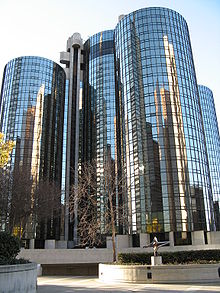
The Los Angeles Union Station , the main train station of Los Angeles, was completed in 1939 on Alameda Street in downtown . The architectural style combines Spanish colonial style, Mission Revival and late Art Deco with Moorish architectural elements . The Los Angeles Public Library on Fifth Street is a rather hidden architectural gem. The library offers, among other things, old painted wooden ceilings and a church-like tower hall.
The 13-story Eastern Columbia Building is in the Broadway Theater District . The Art Deco house was opened in 1930 based on plans by the architect Claud Beelman . The distinctive Watts Towers are in the Watts district and the Capitol Records Building in Hollywood. The Magic Castle is the private clubhouse of the Academy of Magical Arts , a magician's club on Franklin Avenue in Hollywood.
From the Getty Center, Dodger Stadium in Elysian Park or Mount Wilson, there are far-reaching views over the city area when the weather is good. The Encounter Restaurant at Los Angeles International Airport is considered by Angelenos to be the city's secret landmark.
The most famous hotels in Los Angeles are the Hotel Beverly Wilshire (built in 1928), the Chateau Marmont Hotel in West Hollywood (built in 1929 on the model of the Chateau Amboise in the French Loire Valley ), the Beverly Hilton Hotel (1955), the Mondrian Hotel (1959 ) in West Hollywood and the Westin Bonaventure Hotel (1976) in Downtown.

There are numerous masterpieces of villa architecture in Los Angeles and the surrounding area. These include the Gamble House by architects Charles and Henry Green, Richard Neutras Lovell House and the buildings by Irving Gill . Many of the buildings of the architect Irving Gill, who is almost unknown in Europe, have been destroyed or largely changed, which leads to progressive losses of his work.
Other examples of residential architecture are the Schindler House by architect Rudolph Michael Schindler in West Hollywood and Frank Lloyd Wright's Hollyhock House in Little Armenia and Ennis House in Los Feliz. The Hollyhock House in particular is one of Wright's most important works. With its smooth plastered surfaces and ornaments made of precast concrete, the house is reminiscent of a Mayan temple from Central America. In the courtyard there are water features in the shape of an amphitheater.
Other notable buildings are by John Lautner , a student of Frank Lloyd Wright. The most famous example is the Malin Residence , also called Chemosphere , which was built in 1960 . The building, built on a steep embankment above the San Fernando Valley, is reminiscent of an octagonal UFO , with a single concrete pillar supporting the construction, which actually enhances the floating effect.
The so-called Concept Houses , including Pierre Koenig's Bailey House , also known as Case Study House No. 21 and the Stahl House (Case Study House No. 22) . Both houses were built on land previously held as vacant. These can also be visited, such as the Eames House of the designer Charles Eames and his wife, the artist Ray Eames in Santa Monica .
Parks
The parks in Los Angeles and the surrounding area contain numerous recreational and cultural facilities.
The Plaza Church, completed in 1822, is located in El Pueblo de Los Angeles State Historic Park . In Griffith Park , the largest by far Park of Los Angeles, there is the Gene Autry Western Heritage Museum , an observatory , a planetarium and the Los Angeles Zoo . The Exposition Park is home to the Los Angeles Memorial Coliseum , a museum of science and industry and a natural history museum.
In the centrally located Elysian Park is the Dodger Stadium (Chavez Ravine) and also the LA Police Academy. Echo Park is also right in the center of Los Angeles . There, Echo Park Lake served as the backdrop in the successful film Chinatown .
The amusement parks Disneyland and Disney's California Adventure with the 30 meter high Grizzly Peak in nearby Anaheim are not only interesting for children . In the vicinity of the city there is the Angeles National Forest and the endless Pacific beaches - the coast of Los Angeles stretches for about 115 kilometers - in Santa Monica or Venice Beach .
The La Brea Tar Pits , a collection of natural asphalt- filled pits of various sizes, are located in Los Angeles' Hancock Park . The asphalt-rich sediments of Rancho La Brea are known to be one of the richest fossil sites from the Pleistocene or Ice Age. The George C. Page Museum houses an exhibition of animal skeletons, including an extensive collection of the skulls of the Aenocyon dirus , an extinct wolf-like dog. Also in Hancock Park is the Los Angeles County Museum of Art with its art collection.
The Universal Studios Hollywood is a theme park, which is divided into two areas - the "Upper Lot" and "Lower Lot". Both are connected by the world's largest and tallest escalator structure , which extends over several levels. The Upper Lot extends from the entrance of the park to The Simpsons Ride , where the escalators also lead to the lower part of the park. In addition to elaborate live shows, the Upper Lot also offers the actual Studio Tram Tour , which is a main attraction. The Lower Lot is located in the middle of the actual studios and offers three attractions, Jurassic Park - The Ride , Transformers the Ride 3D and Revenge of the Mummy .
Sports
The most popular sports in Los Angeles include the team sports American football , baseball , basketball and ice hockey . Football , lacrosse and volleyball are also very common . Individual sports such as bowling , golf , athletics , swimming and tennis are also very popular.
football
Los Angeles hosted the 1932 Summer Olympics and 1984 Summer Games and will host the Games for the third time in 2028 . The many sporting events in the cosmopolitan city include the annual Los Angeles Marathon and the Countrywide Classic tennis tournament on the ATP Tour . Numerous well-known sports clubs are located in Los Angeles and the surrounding area.
In college football, the UCLA Bruins and the USC Trojans are two successful teams based in Los Angeles. Both teams play in the Pacific-12 Conference of the National Collegiate Athletic Association .
In professional football, the Los Angeles Buccaneers were founded in 1926 for the National Football League in the city. However, this team could not run home games and only played one season. From the 1946 NFL season , the originally Cleveland-based Rams played in Los Angeles. At the same time, the Los Angeles Don of the competing All-America Football Conference began playing. After the demise of the AAFC at the end of the 1949 season, the Rams remained the only professional football team in town. The game was played at the Los Angeles Memorial Coliseum . In 1960 the team of the Chargers of the newly founded American Football League was settled in the city . However, that team moved to San Diego the following season.
In 1984 the Oakland Raiders relocated their game operations to Los Angeles after the team owner and the City of Oakland could not agree on a new stadium. The Raiders also played at the Memorial Coliseum. Since one could not agree with the city of Los Angeles on the construction of a new stadium either in the early 1990s, the Rams moved to St. Louis and the Raiders back to Oakland in 1995 .
Stan Kroenke , the new owner of the Rams, pushed through the construction of a new stadium in Los Angeles, which is why the team returned to Los Angeles in 2016. At the beginning of the 2017 season, the Chargers also moved back to the city. Both teams have been playing in the newly built SoFi Stadium in Inglewood since the 2020 season .
ice Hockey
The Anaheim Ducks are an ice hockey club that plays in the National Hockey League (NHL). In the 2006/07 season they won the Stanley Cup and the division title for the first time . Further successes include winning the conference title in the 2002/03 and 2006/07 seasons . The club, which was founded in 1992, plays its home games at the Honda Center, which has a capacity of 18,000 .
The Los Angeles Kings are an ice hockey team that plays in the National Hockey League (NHL). The greatest successes were winning the Stanley Cup twice , the team celebrated smaller successes in the early 1990s. The team was founded in 1967 and plays its home games at the Staples Center (capacity: 18,000 spectators). From 1988 to 1996 Wayne Gretzky , one of the most successful ice hockey players ever, played with the Kings.
baseball
The Los Angeles Angels of Anaheim are a baseball team that plays in Major League Baseball (MLB). The greatest success was winning the 2002 World Series title . The club, created in 1961, plays its home games at Angel Stadium of Anaheim (capacity: 45,000 spectators).
The Los Angeles Dodgers are a baseball team that plays in Major League Baseball (MLB). The LA Dodgers emerged from the Brooklyn Dodgers by moving in 1959. So far, six World Series titles have been won. The team plays its home games in the 56,000-seat Dodger Stadium .
basketball
The Los Angeles Lakers are a team from the National Basketball Association (NBA). The team won a total of 16 championship titles - the second most behind the Boston Celtics - as well as 28 conference titles and 26 division titles . Since the league was founded, the Lakers have been part of the NBA, and also one of the most successful teams. The home venue is the Staples Center.
With the Los Angeles Clippers , a second team plays in the National Basketball Association (NBA).
The Los Angeles Sparks play in the Women's National Basketball Association (WNBA).
Football
The LA Galaxy are a football team that plays in Major League Soccer (MLS). The greatest successes were winning the CONCACAF Champions Cup 2000 and the national championship titles in 2002 and 2005. The team, founded in 1995, plays its home games in the Home Depot Center (capacity: 27,000 spectators). The most prominent soccer player is David Beckham , who played his first game for Galaxy on July 21, 2007 and was under contract until January 30, 2013.
Motorsport
In August 1982 the Los Angeles Coliseum hosted the Speedway Individual World Championship 1982 final in front of over 30,000 spectators , won by the American Bruce Penhall , with which he was able to defend his world title before he announced his retirement after this race and as Actor went to Hollywood.
freetime and recreation
One of the most popular beaches on the Los Angeles Pacific Coast is Venice Beach . On the Venice Boardwalk, the wide promenade, also known as the Ocean Front Walk , numerous musicians, painters and artists meet on weekends (daily in summer). Venice Beach is a dangerous place at night because of the street gangs and dealers. It is forbidden to stay on the beach after sunset.
Located on palm-fringed beaches and slopes above the Pacific , just north of Venice, Santa Monica is the oldest, largest and most famous seaside resort in the metropolis. Many writers and rock stars live in the health-conscious, liberal district. The place is also known because of the strict rental price controls and building regulations.
The beach colony of Malibu , which is inhabited by numerous celebrities, is also known. Surfrider Beach, south of the pier, has been a popular surfing spot since the 1950s. A large part of the "Malibu Creek State Park" on Las Virgenes Road further north, not far from Mulholland Drive, belonged to the studios of 20th Century Fox . Many Tarzan films were shot on the slopes overgrown by evergreen bushes. In the thousand hectare park there is a lake, several waterfalls and hiking trails.
Along the coast south of Los Angeles, the Pacific Coast Highway runs past the runways of the LAX airport to a stretch of coast with several South Bay beaches: Manhattan Beach, Hermosa Beach and Redondo Beach. A lot has been invested in Long Beach in recent years, including a number of new office buildings and hotels. Long Beach's greatest attraction is the Queen Mary steamer , the flagship of the Cunard Line from the 1930s to the 1960s, now a hotel.
Regular events
spring
Every year on Easter Sunday, the Easter Sunrise Service at the Bowl takes place, an early morning ecumenical Easter service at the Hollywood Bowl in Hollywood . The Jimmy Stewart Relay Marathon , a charity relay race, will be held in Griffith Park in mid-April . Other events in the month of April are the Rose Blossom Festival in Exposition Park Rose Garden, the LA Times Book Festival on the campus of the University of California, Los Angeles , the Pacific Islander Festival in Ken Malloy Harbor Regional Park, the Fiesta Broadway in Homestead Museum and the USC Spring Festival on the University of Southern California campus .
In early May, Native Americans meet for the UCLA Pow Wow on the Intramural Field, UCLA campus. You can see traditional music, dance and handicrafts. Festivals in May include Cinco de Mayo , a downtown street festival , and Family Fun Fest , a Japanese cultural festival celebrating Children's Day in Little Tokyo .
Also in May are the Valley Greek Festival at St. Sophia Cathedral, the NoHo Theater & Arts Festival on Lankershim Boulevard and Magnolia Avenue in North Hollywood, and the UCLA Jazz Reggae Festival on the Intramural Field, UCLA Campus. The last Monday in May, the Memorial Day Parade takes place in Canoga Park, San Fernando Valley.
summer
Numerous festivals are held in June. These include the Playboy Jazz Festival and the Mariachi USA Festival in the Hollywood Bowl. Other festivals include the Los Angeles Independent Film Festival (Directors Guild of America, Sunset Boulevard ) and the Hollywood Ha-Ha Comedy Festival (Noho Arts District, North Hollywood). The Hollywood Bowl Summer Festival takes place at the Hollywood Bowl from late June to mid-September.
The celebrations of the Independence Day , the Fourth of July will be celebrated throughout the city on July 4. Also in July, there are in different places of the city Outfest - LA Gay and Lesbian Film Festival ( gay - and lesbian -Filmfestival) at Echo Park Lake, the Lotus Festival and the Los Angeles Tennis Center in Westwood , the men's tennis tournament Countrywide Classic of ATP tour . Numerous festivals are also held in August. These include the Nisei Week Japanese Festival , a Japanese cultural festival in Little Tokyo, the Los Angeles Festival in numerous locations around the city and the JVC Jazz Festival in the Hollywood Bowl.
The Sweet & Hot Jazz Festival takes place at the Los Angeles Airport Marriott Hotel from August to September . El Diecisis de Septiembre , the celebrations of Mexico's Independence Day, can be seen in Broadway and South Los Angeles on September 16. Events in early and mid-September include the Port of Los Angeles Lobster Festival , a harbor lobster festival on the Harbor Waterfront, and the Fall Moon Festival in Chinatown.
autumn and winter
In October, the Hollywood Film Festival takes place in various locations in Hollywood and the Los Angeles International Short Film Festival is held at the Los Angeles Film School in Hollywood. November features the AFI Los Angeles International Film Festival in various locations around the city, the Mariachi Festival (Mexican music festival) at Mariachi Plaza in Boyle Heights, and the Hollywood Christmas Parade on Sunset Boulevard in Hollywood.
From late November to late December, the Griffith Park Light Festival runs in Griffith Park, Downtown. The Martin Luther King Kingdom Day Parade , a parade to mark the birthday of Martin Luther King on January 15, moves from Martin Luther King Boulevard to Western Boulevard on Martin Luther King Day .
February features the Pan African Film & Art Festival held at the Magic Johnson Theater on Baldwin Hills Crenshaw Plaza and the Chinese New Year with Golden Dragon Parade in North Broadway, Chinatown. Also in February, the Academy Awards will take place at the Kodak Theater in Hollywood. The Los Angeles Marathon will be held at the beginning of March . It runs from Grand Avenue through the entire city center of Los Angeles.
gastronomy

Los Angeles offers a wide range of international restaurants and venues. Popular dishes include traditional American cuisine with lots of meat and potatoes, Korean tempura dishes, sushi, Japanese dishes with udon and soba noodles, Mexican enchilades and tamales, savory burritos and pastrami sandwiches.
There are also Chinese restaurants where abalons, crabs, prawns and duck are served. "Dipped" sandwiches with plenty of turkey, pork, beef or lamb as well as Italian osso buco and risotto are also popular. The Cajun cuisine, also on offer in Los Angeles, offers specialties from the Cajun Country .
trade
One of the most famous shopping streets is Rodeo Drive in Beverly Hills , a suburb of Los Angeles. Numerous well-known fashion brands can be found here. The street is also home to the most expensive shopping malls in the world. These include The Rodeo Collection with five sales levels above and below the ground and the Two Rodeo , which gives the impression of two small European cobblestone streets with a fountain, piazza and balconies. At the end of the street are other large department stores, including Barneys New York and Saks Fifth Avenue .
Macy’s and Bloomingdale’s department stores are located in the nearby Beverly Center and Westfield Century City (formerly Century City Shopping Center & Marketplace ). The shopping mall in Century City, an example of 1960s modernism, was built without a roof in the style of a market square.
There are many retail stores on Melrose Avenue, located between Santa Monica Boulevard and Hoover Street in Silver Lake. Best known is the Red Balls boutique , which can be seen in the opening credits of the television series Melrose Place . Another shopping promenade is the Universal CityWalk next to Universal Studios Hollywood . There are numerous shops and restaurants here. Downtown Los Angeles is also home to many department stores and galleries, including Grand Central Market on South Broadway. Freshly prepared specialties, fruits and vegetables are on offer.
Economy and Infrastructure
business

The city is a leading manufacturing, trading, transportation, and financial center in the United States. The chemical industry, electronics, clothing and food industry, metal processing, construction industry and publishing houses are located there. Los Angeles is the world's largest location for the aircraft and aerospace industries as well as an important center for cinema, radio, television and music productions. Tourism also plays an important role in the Los Angeles economy. With 5.6 million foreign visitors, Los Angeles was the 21st most visited city in the world in 2016. Tourists in the city spent $ 8.1 billion in the same year. Most of the foreign visitors came from Asia, Europe and Latin America.
The city's unemployment rate averaged 13.9% in 2010 , higher than the state of California (12.4%) and also higher than the national average in the US (9.6%). The development in recent years has been as follows: 2006 (5.3%), 2007 (5.6%), 2008 (8.3%), 2009 (12.7%) and 2010 (13.9%).
By the late 1990s, Los Angeles was home to many large financial institutions in the western United States. Mergers with other institutes led to the relocation of the headquarters to other cities. For example, Security Pacific Bank merged with Bank of America in 1992 , First Interstate Bancorp merged with Wells Fargo in 1996, and Great Western Bank merged with Washington Mutual in 1998 . Los Angeles was also the seat of the Pacific Exchange until it closed in 2001. In a ranking of the most important financial centers worldwide, Los Angeles took 17th place (as of 2018).
Numerous large companies and companies as well as research institutions have their headquarters in the city. These include entertainment companies such as 20th Century Fox , DreamWorks SKG , Paramount Pictures , The Walt Disney Company and Warner Bros. , the Academy of Motion Picture Arts and Sciences (known from the Academy Awards), the toy manufacturer Mattel , the manufacturers from computer games Activision and THQ , the aerospace company Northrop Grumman , the space consortium Sea Launch , the oil and gas supplier Unocal , the RAND Corporation ( think tank for the US armed forces), ICANN (administrator of names and addresses on the Internet ), the Hilton hotel chain , the KB Home construction company and the Tokyopop publishing house .
The two Fortune 500 companies AECOM and Reliance Steel & Aluminum Co. also have their headquarters in Los Angeles.
Many laboratories and research centers belonging to the NASA space agency , such as the Dryden Flight Research Center , the Jet Propulsion Laboratory, and the Goldstone Deep Space Communications Complex, have settled in the Los Angeles metropolitan area.
In a ranking of cities according to their quality of life, Los Angeles was ranked 64th out of 231 cities worldwide in 2018.
traffic
Long-distance transport
Highways
Los Angeles is connected to all major cities in the country via a well-developed network of interstate and interstate highways.
On Interstate 5 from Los Angeles you can reach the city of Seattle in the state of Washington in the north and San Diego , the second largest city in California, to the south . The Pacific Coast Highway ( State Highway 1 ) runs north along the California coast to Santa Barbara and San Francisco . The Interstate 10 connects Los Angeles with Phoenix ( Arizona ), the Interstate 15 with Las Vegas ( Nevada ) and Salt Lake City ( Utah ) and the Interstate 40 with Oklahoma City ( Oklahoma ) and Memphis ( Tennessee ).
Intercity buses such as Greyhound Lines are particularly important for traffic within the state of California, but also for long-haul routes .
Rail transport
The city is a major rail hub (transcontinental and regional). The Amtrak railroad operates trains from Los Angeles via Van Nuys to Bakersfield . In Los Angeles you can change to the Pacific Surfliner , which runs from San Diego via Los Angeles to San Luis Obispo . The station Union Station in Los Angeles is the final destination of many main routes through the southern part of the Rocky Mountains lead. It is also the southernmost station on the west coast to Seattle line. The Metrolink regional rail network in southern California connects Los Angeles with all major cities in the region. From Union Station you can take the subway (red line) to downtown, Hollywood and other places.
Air travel

Greater Los Angeles has numerous airports. The largest is Los Angeles International Airport , also commonly known by its IATA abbreviation LAX, which is located southwest of the city center. It has four runways and ten check-in halls. Over 80 million passengers are handled there every year. With this volume of passengers, the airport has been among the top 10 largest airports in the world for many years .
The airports
- Long Beach Airport (Daugherty Field, Long Beach )
- John Wayne Airport ( Orange County )
- Hollywood Burbank Airport ( Burbank )
- Ontario International Airport ( Ontario )
mainly serve national destinations and are noticeably smaller;
- Santa Monica Municipal Airport ( Santa Monica )
- Zamperini Field ( Torrance )
- Van Nuys Airport ( Van Nuys )
serve private aviation.
shipping
The Port of Los Angeles on San Pedro Bay is North America's largest container port and the tenth largest in the world. In 2006 the container volume was 8.5 million TEU (20-foot container ), in 2005 it was 7.5 million TEU. The port, founded by the creation of a Board of Harbor Commissioners on December 9, 1907, covers an area of 30 square kilometers, on a coastal strip of 69 kilometers. Adjacent is the separate port of Long Beach .
The Port of Los Angeles is the largest hub for passenger ship travel on the west coast of the United States; from here over a million passengers are transported annually. The renovated "World Cruise Center" is called the safest passenger shipping complex in the USA. The port is served by the "Pacific Harbor Line" (PHL). From there, the intermodal railroad cars travel through the Alameda Corridor to Los Angeles.
Local transport
In Los Angeles there is no classic transport association, as is known from Germany and other countries. In general, the metro, buses and regional trains (Metrolink) function as separate transport companies, new tickets have to be purchased when changing. In addition, the bus has to be paid appropriately, the bus drivers do not have any change ready. That changed with the introduction of the Transit Access Pass (TAP) in 2007, which works similarly to the Oyster card in London. With the exception of the Metrolink train, for which an extra ticket must still be purchased, all metro trains, express buses and simple buses can be used and paid for with the TAP card, but also many buses in Los Angeles County and the shuttle buses (FlyAway) from LAX airport, and even the city bike rental (Metro Bike Share) accept the card. From November 29, 2019, only the TAP card can be used as a means of payment on the Metro, which is available at the Metro ticket machines.
Rail transport
On July 3, 1873, the first horse trams ran in the city. In 1885 the tram system was electrified. It became famous under the name "Red Cars", although only the long-distance connections to the San Fernando Valley and Orange County were painted red, the wagons in the boundaries of the city of Los Angeles were yellow / white. In 1925, the Red Car network experienced its greatest expansion with around 1,900 network kilometers and the highest number of passengers during the Second World War. But as early as 1936, automobile companies such as General Motors began to buy privately owned tram companies through forward companies and gradually shut them down and replace them with bus routes with buses from the respective vehicle manufacturers (so-called Great American Tram Scandal ). On March 31, 1963, the network was stopped in favor of private transport, the last train from downtown to Hollywood was marked “into oblivion”, which means “into oblivion”. Many freeways were built on the routes of the Red Cars. Nevertheless, major track systems today are preserved and with the dedication (Right-of-Way) , equipped which would simplify reactivation. After a 27-year hiatus, a streetcar ran again in Los Angeles on July 14, 1990. Today, the 117-kilometer-long light rail network is part of the Los Angeles Metro .
The metro network has six lines, of which only the “Red Line” and the “Purple Line” are full subways , the other four are light rail lines . The "Red Line" opened on January 30, 1993 on a 28-kilometer stretch of line. The system, also known as MetroRail, is operated by the Los Angeles County Metropolitan Transportation Authority (LACMTA). Since the 1980s, the city has invested billions of dollars in renewing the rail network - with only moderate success. The urban sprawl is currently so advanced that stops are barely accessible on foot. The work on a subway network was temporarily suspended because the costs on the earthquake- prone west coast were too high. In contrast, the urban railway network, which runs mainly on the surface, is being expanded more quickly. After the “Blue Line” (1990), the “Green Line” (1995) and the “Gold Line” (2003), the fourth tram line was opened in Los Angeles in 2012 with the “Expo Line”. It connects downtown with the Pacific coast near Santa Monica . Between 2006 and April 2012, the first nine miles (14.5 kilometers) long section between the 23rd Street and Culver City stops was built, and the extension to the Pacific coast was opened in May 2016.
Two bus routes, the Orange Line and the Silver Line , are known as Metrobus and are also noted on the Metro route map. They are express buses that mostly run on their own lane and rarely stop.
Bicycles can be taken along free of charge on both the metro trains and the metro buses. All buses have an attached wheel carrier for two to three wheels at the front. The metro trains have extra parking spaces for bicycles, which are marked with a yellow wheel symbol. In contrast to the Metrolink trains, e-bikes can also be taken on the metro .
Under the name Metrolink , the suburban rail traffic in the greater area of the Californian city of Los Angeles is operated with seven lines. All lines start at Union Station in Los Angeles. The Metrolink trains are mainly designed for commuters from the suburbs in the morning and in the evening from Los Angeles, so on weekends the connections are reduced to around a third compared to those on working days. The maximum speed of the trains of up to 140 km / h is relatively high by American standards. Almost exclusively double-decker wagons are used.
You can take your bike with you on all Metrolink trains free of charge. Each wagon can accommodate up to three wheels. Some trains also have a yellow, so-called bike-car wagon, where up to nine bicycles can be transported.
Metrolink tickets are also valid for onward travel on the Los Angeles metro and buses.
Road traffic
Trolleybuses ran in the city between September 11, 1910 and 1915, from 1922 to 1937, and from August 3, 1947 to March 31, 1963 in the city. Buses run roughly every 15 minutes between five in the morning and two in the morning along the most important main roads; there are also express and night lines. Timetables can be found at numerous bus terminals .
The city's bus network is the backbone of public transport, but it is mostly used by the less wage earners. Numerous bus companies serve the metropolitan region, the largest of which is the public “Los Angeles County Metropolitan Transportation Authority” (LACMTA), which operates a route network of around 8,000 kilometers with 2,600 buses. In the northern and northwestern part the buses of the "Santa Monica Big Blue Bus Line" and in the southern part "Orange County Transit" operate. In the airport area, the "Culver City Bus Company" operates a small route network.
The buses of LACMTA , which also operates the metro, consist of three categories. The orange-colored Metro-Local buses drive most of the main roads and stop at a short distance (200 meters). They have line numbers from 1-399 and 600 numbers. The Metro Rapid buses are fire red and mostly use the same lines as the Metro Local buses, but they only stop at the major intersections. The line numbers are 700 and 900 numbers. In addition, there are eight express bus lines, the Metro-Express buses, which are mostly run on motorways and stop very rarely. The main color of the Metro Express buses is orange, older buses also have a dark blue paintwork. The line numbers have numbers around 500.
Overall, only about ten percent of the city's residents use public transport. Nine out of ten employees drive to work in their own car. Los Angeles also has the highest density of motor vehicles in the world. Multi-lane highways in the United States have become a symbol of traffic in the 20th century. Despite the well-developed motorway network, you can usually no longer get around very quickly by car in Los Angeles. Individual movement by car and the air pollution ( smog ) it generates are problems of the first order today.
In Los Angeles, millions of commuters spend an average of an hour each way on the freeways. Immense traffic congestion is the result, the cause of which lies in the extensive settlement structure. The Californian metropolis still had the world's largest rail network for local transport in the 1920s. Even then, people didn't settle there as compactly as in Europe. In the decades that followed, the tram was gradually replaced by the car. In order to reduce traffic jams, the autobahns have been expanded to include up to 15 strips since the 1940s . In addition, attempts are being made by setting up the so-called Diamond Lanes , which are reserved for car pools, to promote the formation of car pools and thus to reduce the volume of traffic .
media
Print media
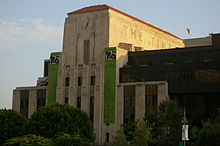
The largest daily newspaper in the region is the Los Angeles Times , while La Opinión is the largest Spanish-language newspaper. Investor's Business Daily is based in Los Angeles, with headquarters in Playa Del Rey .
There are also a number of smaller regional newspapers, alternative weeklies and magazines, including the Daily News (with a focus on the San Fernando Valley), LA Weekly, Los Angeles CityBeat, LA Record (reports on the music scene in the greater Los Angeles area), "Los Angeles Magazine", "Los Angeles Business Journal", "Los Angeles Daily Journal" (prestigious legal magazine), The Hollywood Reporter and Variety (entertainment magazines) and "Los Angeles Downtown News".
In addition to the English and Spanish language newspapers, numerous local magazines for immigrants are published in their mother tongue, including Armenian, Korean, Dutch, Persian, Russian, Chinese and Japanese. Many cities around Los Angeles have their own daily newspapers, some of which are also read in Los Angeles. Examples are "The Daily Breeze" (for South Bay), and "The Long Beach Press-Telegram".
Radio and television
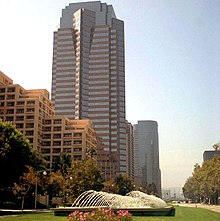
Greater Los Angeles has a large number of local radio and television stations and is the second largest media market in North America (after New York ). The first radio station in Los Angeles was KNX. It began broadcasting experimental programs in 1920 and was granted a commercial broadcast license in December 1921. The first television station in Los Angeles (and the first in California ) was KTLA, which began broadcasting programs on January 22, 1947.
The major networked television stations in Los Angeles are KABC-TV 7 ( ABC ), KCBS 2 ( CBS ), KNBC 4 ( NBC ), KTTV 11 ( FOX ), KTLA 5 ( The CW ), KCOP-TV 13 ( MyNetworkTV ) and KPXN 30 ( ION Television ). There are also three PBS stations in the area including KCET 28, KOCE-TV 50, 58 and KLCS. World TV operates the stations KNET-LP 25 and LP KSFV-6 on two TV channels. There are also several Spanish-speaking television networks, including KMEX-TV 34 ( Univision ), KFTR 46 ( TeleFutura ), KVEA 52 ( Telemundo ) and KAZA 54 ( Azteca América ). KTBN 40 ( Trinity Broadcasting Network ) is a religious station.
Several independent TV stations are located in the region including KCAL-TV-9 (owned by CBS Corporation ), KSCI 18 (mainly focuses on programming in Asian languages), KWHY-TV 22 (broadcasts in Spanish), KNLA-LP 27 (Spanish language), KSMV-LP 33 (Variety), KPAL-LP 38, KXLA 44, KDOC-TV 56 (with a focus on classic programs and local sports clubs), KJLA 57 (Variety), and KRCA 62 ( Spanish language).
Film industry
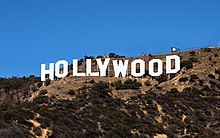
Hollywood is not just a district of Los Angeles, but a synonym for the American film industry. Founded by the Wilcox family on February 1, 1887, the place was once the site of one of the largest Presbyterian churches in the country and was about eight miles from Los Angeles in 1900. It began its ascent in 1911 when David Horsley's Nestor Company opened the first film studio here. It is now a museum and houses a collection of interesting memorabilia from the silent movie era .
In 1911, 15 other companies called “Independents” moved from New York , the then center of the film industry. There were several reasons for this move. The most important ones were the more suitable climate and the longer days (at that time you didn't have adequate artificial light, so you were shooting either outdoors or in a studio with a glass roof or something similar). Another decisive factor was undoubtedly the great distance to New York, from where the powerful Motion Picture Patents Company (MPPC) threatened all non-affiliated companies with high fines and license fees.
The new branch of industry expanded rapidly and brought quick success and wealth. Numerous directors and producers such as Cecil B. DeMille , Samuel Goldwyn , Jesse L. Lasky and Adolph Zukor had opened offices in Hollywood. But it was not until DW Griffith's silent film epic The Birth of a Nation (1915) that film production developed into an independent industry with appropriate technology and specialization. Numerous smaller companies went bankrupt at this time or were taken over by the large studios, which almost without exception moved to new locations further outside such as Culver City, Burbank or West Los Angeles in the 1930s. Of the big names, only Paramount Pictures stayed in Hollywood. In 1927 Los Angeles had 247 film companies, 58 large film studios and around 800 feature films.
In addition to the antitrust legislation of the US government, the recovering film industry abroad after the Second World War and, of course, television were responsible for the decline of the studios in the 1950s . A new upswing only began in the 1970s and 1980s with directors such as Steven Spielberg and George Lucas . They developed the concept of the blockbuster - an expensively produced monumental film with numerous special effects that was intended to appeal to as broad an audience as possible. Thanks to a trend that started back then and the financial consolidation of the US media companies, Hollywood is still today a symbol of the continued success of the US film industry and professionally produced, entertaining films with world-famous actors and happy endings.
Due to its proximity to the film industry, the city itself has become the setting for many films.
education
The city is home to numerous important universities, colleges, research and educational institutions.
The California State University, Los Angeles (CSULA) is a state of three universities in Los Angeles. 21,000 students are enrolled at it. CSULA was founded as Los Angeles State College in 1947 and renamed California State College at Los Angeles in 1964 . It received its current name in 1972 when it became part of the California State University system .
Another state university is California State University, Northridge (CSUN). It is one of the largest colleges in the California State University system. The college opened as San Fernando Valley State College in 1958 and was given its current name in 1972. About 33,000 students are enrolled at it.
The state University of California, Los Angeles (UCLA) was founded in 1919 and is the University of California's second oldest campus . In 2003 around 37,000 students were enrolled. More than 22,000 employees work at the twelve faculties . The Anderson School of Management - one of the most famous business schools in the USA - is part of UCLA.
The University of Southern California (USC) is the oldest private university in Southern California . It was opened in 1880. The range of courses at the university has been steadily expanded; in the early days, a new faculty was added almost every year . Today it employs around 3,000 full-time teachers and around 32,000 students are enrolled in it.
The Loyola Marymount University (LMU) is one of 28 member institutions of the Association of Jesuit Colleges and Universities . Around 9,000 students are currently enrolled. The college was formed in 1973 from the merger of Marymount College with Loyola University. The origins of the educational institution go back to St. Vincent's College , which opened in 1865.
The public schools Los Angeles' are from the United School District of Los Angeles (Los Angeles Unified School District) managed. Known from the media is Crenshaw High School in South Los Angeles , where around 2,600 students are currently studying. The high school was, among other things, the location of the films Boyz n the Hood from 1991 and Love & Basketball from 2000. The television series Moesha (1996-2001) also takes place at the school.
In 1986 there were two major fires in the Los Angeles Public Library, the central public library of Los Angeles (2.1 million volumes). The facility, which was completed in 1926, was reopened in 1993 after a renovation. Since 2001, the library has borne the name of former Los Angeles Mayor Richard Riordan .
sons and daughters of the town
The city is home to numerous prominent personalities. These include the actresses Bridget Fonda , Jodie Foster , Angelina Jolie , Elizabeth Mitchell , Marilyn Monroe , Mary-Kate and Ashley Olsen , Gwyneth Paltrow and Anna May Wong , the actor Leonardo DiCaprio , the actor and singer David Faustino , the producer and Rapper Dr. Dre , the rapper and actor Ice Cube , the rapper The Game , the singer and producer Michael Landau , the singer and pianist Randy Newman , the basketball player Michael Cooper , the tennis player Darlene Hard , the composer John Cage , the musician James Hetfield , the Science Fiction writer Larry Niven and the sculptor Isamu Noguchi .
See also
literature
- Stefan Bratzel: Extremes of mobility. Development and consequences of traffic policy in Los Angeles. Birkhäuser, Basel 1995, ISBN 3-7643-5186-1 .
- Mike Davis : City of Quartz. Excavations of the future in Los Angeles. Verlag Schwarze Risse, Berlin 1994. ISBN 3-924737-23-1 .
- Mike Davis: Ecology of Fear. Piper, Munich 2004, ISBN 3-492-23819-X .
- Lung Ho Nu: A comparison of the metropolitan areas of the industrialized countries: London, Paris, Los Angeles, Tokyo, Minsk. Nusser, Munich 1992, ISBN 3-88091-580-6 .
- Roger Keil : cosmopolitan city. City of the world. Internationalization and Local Politics in Los Angeles. Westfälisches Dampfboot Verlag, Münster 2001, ISBN 3-924550-76-X .
- Bernd-Peter Lange (Ed.), Hans-Peter Rodenberg (Ed.): The new metropolises. Los Angeles - London. Argument Verlag, Hamburg 1994, ISBN 3-88619-713-1 .
- Olaf Kühne : City - Landscape - Hybridity. Aesthetic references in postmodern Los Angeles with its modern persistence. Springer VS, Wiesbaden 2012, ISBN 978-3-531-18661-0 .
- Vincent Brook: Land of Smoke and Mirrors: A Cultural History of Los Angeles . Rutgers University Press, New Brunswick 2013, ISBN 978-0-8135-5458-7
- Herbert Gold and Thomas Höpker (also photos): The future is looking for its city . In: Geo-Magazin. Hamburg 1978.9, pp. 32-58. (Informative, experience report) ISSN 0342-8311
Web links
|
Further content in the sister projects of Wikipedia:
|
||
|
|
Commons | - Media content (category) |
|
|
Wiktionary | - Dictionary entries |
|
|
Wikinews | - News |
|
|
Wikiquote | - Quotes |
|
|
Wikivoyage | - Travel Guide |
- Official site of the City of Los Angeles (English)
Individual evidence
- ↑ The pronunciation, however, is not standardized, see Gina Pollack, How To Speak LA: Your Guide To The City's Most Debated And Mispronounced Words , LA is from July 22, 2019. Access date: September 18, 2020.
- ↑ City of Los Angeles |. In: lacity.org. Accessed June 9, 2020 .
- ↑ a b c d Los Angeles population according to the United States Census Bureau
- ↑ a b U.S. Census Bureau: Population figures of the city ( Memento from January 16, 2013 in the Internet Archive )
- ↑ US Census Bureau: Population Numbers of the Agglomeration
- ↑ a b U.S. Census Bureau: Population of the metropolitan area
- ↑ Bureau of Economic Analysis: Gross Domestic Product by Metropolitan Area, 2017. (PDF; 951 kB) September 18, 2018, accessed on May 29, 2019 (English).
- ^ A b Los Angeles Almanac: The Settlement of Los Angeles
- ↑ City-data.com: Los Angeles Detailed Profile
- ↑ County of Los Angeles: Historical Disaster Information ( March 6, 2008 memento in the Internet Archive )
- ↑ Researchers predict severe earthquake in California. In: Der Spiegel . April 15, 2008, accessed on June 9, 2009 (chs / dpa / AP / AFP).
- ↑ Message ci14383980 ( Memento from May 9, 2009 in the Internet Archive ) of the Geological Service of the USA (English)
- ^ City of Los Angeles: boroughs
- ↑ Thieme, G./Laux, HD (1996): Los Angeles. Prototype of a cosmopolitan city on the threshold of the 21st century. In: Geographische Rundschau 48, no. 2, 82–88. S. 82. See also Rojas, J. (2003): The Enacted Environment: Examining the Streets and Yards of East Los Angeles. In: Wilson, Ch./Groth, P. (Ed.): Everyday America. Cultural Landscape Studies after JB Jackson. Berkeley, Los Angeles, London, 275-292. Laux, HD / Thieme, G. (2008): Los Angeles Restructing. In: Geographische Rundschau International 4, no. 2, 36–43. Laslett, JHM (1996): Historical Perspectives. Immigration and the Rise of a Distinctive Urban Region. In: Waldinger, R./Bozorgmehr, M. (Ed.): Ethnic Los Angeles. New York, 39-77.
- ↑ Jencks, C. (1993): Heteropolis. Los Angeles, the Riots and the Strange Beauty of Hetero-Architecture. London, Berlin, New York. P. 32.
- ↑ a b see Kühne, O. (2012): City - Landscape - Hybridity. Aesthetic references in postmodern Los Angeles with its modern persistence. Wiesbaden.
- ^ Hall, T. (2006): Urban Geography. London, New York.
- ^ Soja, EW (1993): Los Angeles, an outward-facing city: The development of the postmodern metropolis in the USA. In: Dortmund contributions to spatial planning 62. Dortmund, 213–228.
- ^ Soja, EW (2000): Postmetropolis. Critical Studies of Cities and Regions. Oxford.
- ^ Sieverts, Th. (2001 [1997]): Zwischenstadt. Between place and world, space and time, city and country. Braunschweig, Wiesbaden.
- ^ Garreau, J. (1991): Edge City. Life on the New Frontier. New York.
- ^ Lang, RE (2003): Edgeless Cities. Exploring the Elusive Metropolis. Washington.
- ↑ see Beauregard, RA (2006): When America Became Suburban. Minneapolis, London. See also Teaford, JC (2007): The American Suburb. The basics. London, New York.
- ↑ Michael J. Dear: The Los Angeles School of Urbanism . In: Geographical Rundschau . tape 57 , no. 1 , 2005, p. 30-37 .
- ^ Emergency-management.net: Disasters in Los Angeles 1926-2003
- ↑ National Weather Service: Weather records at Los Angeles ( Memento of February 29, 2008 in the Internet Archive )
- ↑ National Climatic Data Center: Selected US Heat Wave Records, June – July 2006 (PDF; 15 kB)
- ^ WMO: World Weather Information Service
- ↑ American Lung Association: State of the Air 2007 ( Memento from July 31, 2008 in the Internet Archive )
- ^ Fleet of electric trucks is bound for Port of Los Angeles. In: articles.latimes.com. September 16, 2010, accessed February 15, 2015 .
- ^ Allen County Public Library Genealogy Center: The Historical Society of Southern California quarterly . Los Angeles, Calif. : The Society, 1949 ( archive.org [accessed June 1, 2018]).
- ^ University of California Libraries: Sixty years in Southern California, 1853-1913, containing the reminiscences of Harris Newmark . New York, The Knickerbocker press, 1916 ( archive.org [accessed June 1, 2018]).
- ↑ Kevin Starr, Deconstructing Los Angeles: The San Fernando Valley thinks it's independent enough to secede from the city. But instead of dwelling in self-pity, the region should become the engine of LA reform. , Los Angeles Times, May 26, 1996.
- ↑ County of Los Angeles: Disasters in California since 1950 ( Memento from September 5, 2007 in the Internet Archive ) (PDF; 75 kB)
- ^ Catholic-hierarchy.org: Archdiocese of Los Angeles
- ↑ ldschurchtemples.com: Los Angeles California Temple
- ^ Adherents.com: The Largest Jewish Communities
- ↑ Fewer latinos will speak Spanish […] , accessed on April 9, 2015.
- ^ "Between Two Worlds: How Young Latinos Come of Age in America," accessed April 9, 2015.
- ^ Mapping the 2010 US Census , By MATTHEW BLOCH, SHAN CARTER and ALAN McLEAN.
- ↑ According to neighborhoodscout.com , the annual homicide rate is 0.25 in Compton and 0.04 in the US, both per 1000 people.
- ↑ LAPD: Crime Maps and COMPSTAT Crime Statistics
- ↑ Los Angeles Almanac: Biography of Antonio Villaraigosa - Mayor of Los Angeles ( Memento of February 7, 2009 in the Internet Archive )
- ↑ Crime rates in Los Angeles rise 12.6 percent foxla.com, January 14, 2016
- ^ City of Los Angeles: Sister cities of Los Angeles (twinned cities of Los Angeles). Retrieved October 24, 2010 .
- ^ Sister Cities of Los Angeles: Official Website
- ^ Borislav Stanic, Museum Compendium to Los Angeles , Museon Publishing, Beverly Hills 2014, ISBN 978-1-889224-03-9 .
- ↑ Borislav Stanic, Museum Compendium to Los Angeles , Museon Publishing, Beverly Hills 2014, ISBN 978-1-889224-03-9 , pp. 103-105.
- ↑ Borislav Stanic, Museum Compendium to Los Angeles , Museon Publishing, Beverly Hills 2014, ISBN 978-1-889224-03-9 , pp. 99-103.
- ↑ Global Destination Cities Report 2016. (PDF) Mastercard, archived from the original on September 24, 2016 ; accessed on July 11, 2018 .
- ^ US Bureau of Labor Statistics: Local Area Unemployment Statistics
- ↑ The Global Financial Centers Index 23. (PDF) Archived from the original on March 27, 2018 ; accessed on July 13, 2018 .
- ↑ Mercer's 2018 Quality of Living Rankings. Retrieved July 30, 2018 .
- ^ American Association of Port Authorities: Port Industry Statistics
- ↑ Armin Thurnher : 20 years ago in the Falter: How Los Angeles got around the largest tram network in the world. Falter , No. 18/09, April 29, 2009, p. 3
- ↑ Los Angeles Public Transportation ( memento October 17, 2009 on WebCite )
- ↑ Urbanrail.net: Los Angeles County Metropolitan Transportation Authority
- ^ University of Manitoba: All-Time List of North American Trolleybus Systems
- ^ LACMTA: Facts at a Glance
- ↑ L'Estrange Fawcett: The World of Film. Amalthea-Verlag, Zurich, Leipzig, Vienna 1928, pp. 53 and 61 (translated by C. Zell, supplemented by S. Walter Fischer)

